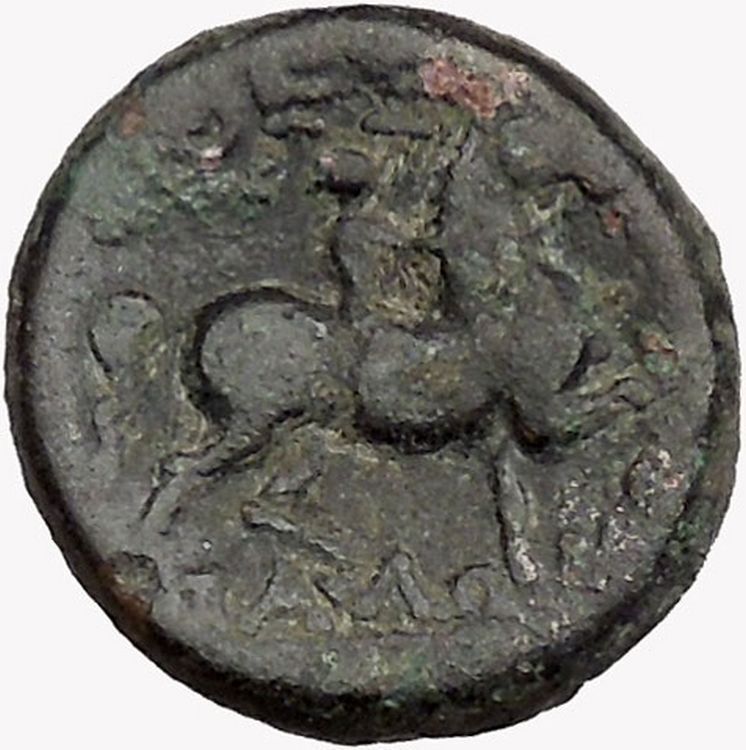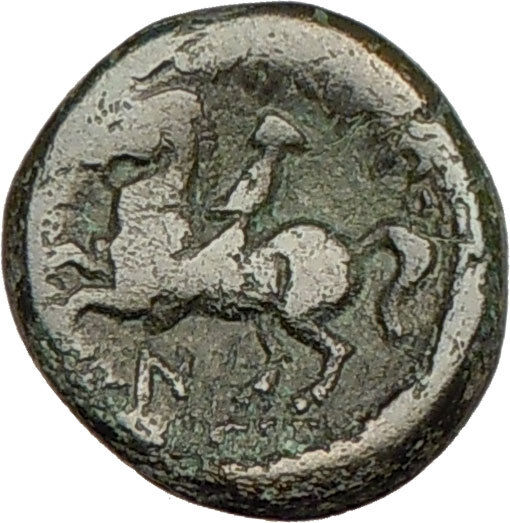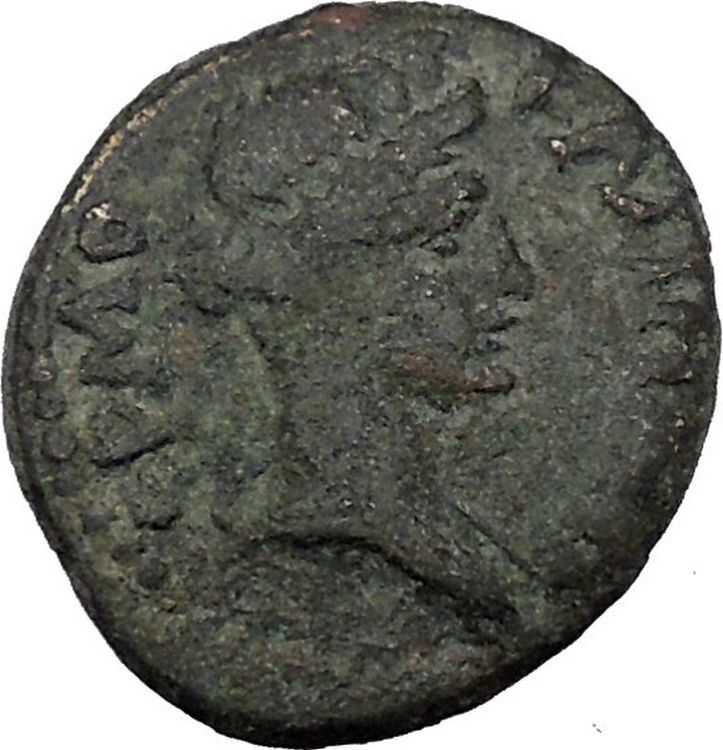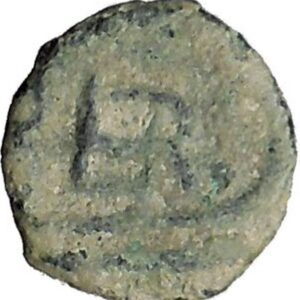|
Greek Coin of Seleucid Kingdom
Demetrios II, Nikator – King: 146-138 B.C.
Bronze 22mm (14.06 grams) Struck during the first reign, circa 146-138 B.C.
Antioch on the Orontes mint
Reference: HGC 9, 992 (Rare R1-R2); SC 1912
Laureate head of Zeus right.
ΒΑΣΙΛΕΩΣ ΔΗΜΗTPIOY / ΘΕΟΥ ΦΙΛAΔΕΛΦΟΥ NIKATOPOΣ, Apollo standing left, holding arrow and grounded bow; symbols in exergue.
You are bidding on the exact item pictured, provided with a Certificate of Authenticity and Lifetime Guarantee of Authenticity.
![The Jupiter de Smyrne, discovered in Smyrna in 1680[1]](https://upload.wikimedia.org/wikipedia/commons/thumb/c/c8/Jupiter_Smyrna_Louvre_Ma13.jpg/200px-Jupiter_Smyrna_Louvre_Ma13.jpg) In the ancient Greek religion, Zeus was the “Father of Gods and men” who ruled the Olympians of Mount Olympus as a father ruled the family. He was the god of sky and thunder in Greek mythology. His Roman counterpart is Jupiter and Etruscan counterpart is Tinia. In the ancient Greek religion, Zeus was the “Father of Gods and men” who ruled the Olympians of Mount Olympus as a father ruled the family. He was the god of sky and thunder in Greek mythology. His Roman counterpart is Jupiter and Etruscan counterpart is Tinia.
Zeus was the child of Cronus and Rhea, and the youngest of his siblings. In most traditions he was married to Hera, although, at the oracle of Dodona, his consort was Dione: according to the Iliad, he is the father of Aphrodite by Dione. He is known for his erotic escapades. These resulted in many godly and heroic offspring, including Athena, Apollo and Artemis, Hermes, Persephone (by Demeter), Dionysus, Perseus, Heracles, Helen of Troy, Minos, and the Muses (by Mnemosyne); by Hera, he is usually said to have fathered Ares, Hebe and Hephaestus.
As Walter Burkert points out in his book, Greek Religion, “Even the gods who are not his natural children address him as Father, and all the gods rise in his presence.” For the Greeks, he was the King of the Gods, who oversaw the universe. As Pausanias observed, “That Zeus is king in heaven is a saying common to all men”. In Hesiod’s Theogony Zeus assigns the various gods their roles. In the Homeric Hymns he is referred to as the chieftain of the gods.
His symbols are the thunderbolt, eagle, bull, and oak. In addition to his Indo-European inheritance, the classical “cloud-gatherer” also derives certain iconographic traits from the cultures of the Ancient Near East, such as the scepter. Zeus is frequently depicted by Greek artists in one of two poses: standing, striding forward, with a thunderbolt leveled in his raised right hand, or seated in majesty.
 In Greek and Roman mythology, Apollo, is one of the most important and diverse of the Olympian deities. The ideal of the kouros (a beardless youth), Apollo has been variously recognized as a god of light and the sun; truth and prophecy; archery; medicine and healing; music, poetry, and the arts; and more. Apollo is the son of Zeus and Leto, and has a twin sister, the chaste huntress Artemis. Apollo is known in Greek-influenced Etruscan mythology as Apulu. Apollo was worshiped in both ancient Greek and Roman religion, as well as in the modern Greco–Roman Neopaganism. In Greek and Roman mythology, Apollo, is one of the most important and diverse of the Olympian deities. The ideal of the kouros (a beardless youth), Apollo has been variously recognized as a god of light and the sun; truth and prophecy; archery; medicine and healing; music, poetry, and the arts; and more. Apollo is the son of Zeus and Leto, and has a twin sister, the chaste huntress Artemis. Apollo is known in Greek-influenced Etruscan mythology as Apulu. Apollo was worshiped in both ancient Greek and Roman religion, as well as in the modern Greco–Roman Neopaganism.
As the patron of Delphi (Pythian Apollo), Apollo was an oracular god – the prophetic deity of the Delphic Oracle. Medicine and healing were associated with Apollo, whether through the god himself or mediated through his son Asclepius, yet Apollo was also seen as a god who could bring ill-health and deadly plague as well as one who had the ability to cure. Amongst the god’s custodial charges, Apollo became associated with dominion over colonists, and as the patron defender of herds and flocks. As the leader of the Muses (Apollon Musagetes) and director of their choir, Apollo functioned as the patron god of music and poetry. Hermes created the lyre for him, and the instrument became a common attribute of Apollo. Hymns sung to Apollo were called paeans.
In Hellenistic times, especially during the third century BCE, as Apollo Helios he became identified among Greeks with Helios, god of the sun, and his sister Artemis similarly equated with Selene, goddess of the moon. In Latin texts, on the other hand, Joseph Fontenrose declared himself unable to find any conflation of Apollo with Sol among the Augustan poets of the first century, not even in the conjurations of Aeneas and Latinus in Aeneid XII (161-215). Apollo and Helios/Sol remained separate beings in literary and mythological texts until the third century CE.
Demetrius II (Ancient Greek: Δημήτριος Β`, Dēmḗtrios B; died 125 BC), called Nicator (Ancient Greek: Νικάτωρ, Nikátōr, “the Victor”), was one of the sons of Demetrius I Soter, brother of Antiochus VII Sidetes and his mother could have been Laodice V. He ruled the Seleucid Empire for two periods, separated by a number of years of captivity in Hyrcania in Parthia.
In exile
As a young boy, he fled to Crete after the death of his father, his mother and his older brother, when Alexander Balas usurped the Seleucid throne.
First reign
About 147 BC he returned to the Seleukid Kingdom, and with the backing of Ptolemy VI Philometor, king of Egypt, regained his father’s throne. The Egyptian king also divorced his daughter Cleopatra Thea from Balas and remarried her to Demetrius. Alexander fled to the Nabateans who, anxious to stay on good terms with Egypt, cut off his head.
However, Demetrius was not a popular king. The people of the Seleukid Kingdom had little respect for the young boy, who had come to power with the help of Egypt and Cretan mercenaries led by the ruthless condottiere Lasthenes. The Antiochenians offered the Seleucid throne to Ptolemy VI, who had already conquered most of southern the Seleukid Kingdom for his own interest. However, he insisted Demetrius would become king, knowing that Rome would never tolerate a unified Hellenistic state, and the year after Ptolemy VI was killed when Alexander Balas made a last desperate attempt to regain his throne. The Egyptian troops marched home, leaderless and disillusioned, and with Balas dead as well Demetrius became sole master of the Seleucid kingdom.
But new troubles soon arose. The pillaging of the Cretan soldiers caused the Antiochenians to rise in rebellion, and only after terrible massacres was order restored. Soon after, the general Diodotus conquered Antioch and had his protégé Antiochus VI Dionysus, the infant son of Alexander Balas, proclaimed king. Demetrius proved unable to retake the capital, instead establishing himself in Seleucia. Diodotus had Antiochus VI deposed a few years later, and made himself king as Tryphon, but the division of the kingdom between the legitimate Seleucid heir and the usurper in Antioch persisted.
Defeat and captivity
In 139 BC Parthian activity forced Demetrius to take action. He marched against Mithradates I, king of Parthia and was initially successful, but was defeated in the Parthian mountains and taken prisoner the following year. The Babylonian province of the Seleucid empire became Parthian, but in the Seleukid Kingdom was the dynasty’s grip was reassured under Antiochus VII Sidetes, the younger brother of Demetrius, who also married Cleopatra Thea.
King Mithradates had kept Demetrius II alive and even married him to a Parthian princess named Rhodogune, with whom he had children. However, Demetrius was restless and twice tried to escape from his exile in Hyrcania on the shores of the Caspian sea, once with the help of his friend Kallimander, who had gone to great lengths to rescue the king: he had travelled incognito through Babylonia and Parthia. When the two friends were captured, the Parthian king did not punish Kallimander but rewarded him for his fidelity to Demetrius. The second time Demetrius was captured when he tried to escape, Mithradates humiliated him by giving him a golden set of dice, thus hinting that Demetrius II was a restless child who needed toys. It was however for political reasons that the Parthians treated Demetrius II kindly.
In 130 BC Antiochus Sidetes felt secure enough to march against Parthia, and scored massive initial successes. Now Phraates II made what he thought was a powerful move: he released Demetrius, hoping that the two brothers would start a civil war. However, Sidetes was defeated soon after his brother’s release and never met him. Phraates II set people to pursue Demetrius, but he managed to safely return home to the Seleukid Kingdom and regained his throne and his queen as well.
A failed second reign
However, the Seleucid kingdom was now but a shadow of its former glory, and Demetrius had a hard time ruling even in the Seleukid Kingdom. Recollections of his cruelties and vices – along with his humiliating defeat – caused him to be greatly detested. The Egyptian queen Cleopatra II set up an army for Demetrius, hoping to engage him in her civil wars against her brother king Ptolemy VIII, but this only added to his grief. The troops soon deserted, and king Ptolemy VIII reacted by setting up yet another usurper, a man named Alexander II Zabinas against Demetrius.
In 126 BC Demetrius was defeated in a battle at Damascus. He fled to Ptolemais but his wife Cleopatra Thea closed the gates against him. He was killed on a ship near Tyre, after his wife had deserted him. His miserable death after being captured and possibly tortured, was a fitting epitaph to the many shortcomings of his reign. Demetrius II was certainly incapable of handling the developing threats to the Seleucid empire, but his reputation for cruelty was probably undeserved. He was only around fourteen at his coronation, and the real power was in the hands of others. He was succeeded by his queen Cleopatra Thea and then by two of their sons, Seleucus V Philometor and Antiochus VIII Grypus.
|
Demetrius II Nicator
Seleucid dynasty
Born: Unknown Died: 125 BC |
Preceded by
Alexander Balas |
Seleucid King
146–139 BC
with Antiochus VI Dionysus (145–142 BC)
Diodotus Tryphon (142–139 BC) |
Succeeded by
Antiochus VII Sidetes |
Preceded by
Antiochus VII Sidetes |
Seleucid King
129–126 BC
with Alexander II Zabinas (129–123 BC) |
Succeeded by
Cleopatra Thea |
Seleucid Empire
Σελεύκεια
Seleúkeia |

|
312 BC–63 BC |
↓ |
|
|
The Seleucid Empire in 301 BC.
|
The Seleucid Empire was a Hellenistic state ruled by the Seleucid dynasty founded by Seleucus I Nicator following the division of the empire created by Alexander the Great. Seleucus received Babylonia and, from there, expanded his dominions to include much of Alexander’s near eastern territories. At the height of its power, it included central Anatolia, the Levant, Mesopotamia, Kuwait, Persia, Afghanistan, Turkmenistan, and northwest parts of India.
The Seleucid Empire was a major center of Hellenistic culture that maintained the preeminence of Greek customs where a Greek-Macedonian political elite dominated, mostly in the urban areas. The Greek population of the cities who formed the dominant elite were reinforced by emigration from Greece. Seleucid expansion into Anatolia and Greece was abruptly halted after decisive defeats at the hands of the Roman army. Their attempts to defeat their old enemy Ptolemaic Egypt were frustrated by Roman demands. Much of the eastern part of the empire was conquered by the Parthians under Mithridates I of Parthia in the mid-2nd century BC, yet the Seleucid kings continued to rule a rump state from the Seleukid Kingdom until the invasion by Armenian king Tigranes the Great and their ultimate overthrow by the Roman general Pompey.
|




![The Jupiter de Smyrne, discovered in Smyrna in 1680[1]](https://upload.wikimedia.org/wikipedia/commons/thumb/c/c8/Jupiter_Smyrna_Louvre_Ma13.jpg/200px-Jupiter_Smyrna_Louvre_Ma13.jpg)
 In Greek and Roman mythology, Apollo, is one of the most important and diverse of the Olympian deities. The ideal of the kouros (a beardless youth), Apollo has been variously recognized as a god of light and the sun; truth and prophecy; archery; medicine and healing; music, poetry, and the arts; and more. Apollo is the son of Zeus and Leto, and has a twin sister, the chaste huntress Artemis. Apollo is known in Greek-influenced Etruscan mythology as Apulu. Apollo was worshiped in both ancient Greek and Roman religion, as well as in the modern Greco–Roman Neopaganism.
In Greek and Roman mythology, Apollo, is one of the most important and diverse of the Olympian deities. The ideal of the kouros (a beardless youth), Apollo has been variously recognized as a god of light and the sun; truth and prophecy; archery; medicine and healing; music, poetry, and the arts; and more. Apollo is the son of Zeus and Leto, and has a twin sister, the chaste huntress Artemis. Apollo is known in Greek-influenced Etruscan mythology as Apulu. Apollo was worshiped in both ancient Greek and Roman religion, as well as in the modern Greco–Roman Neopaganism.





